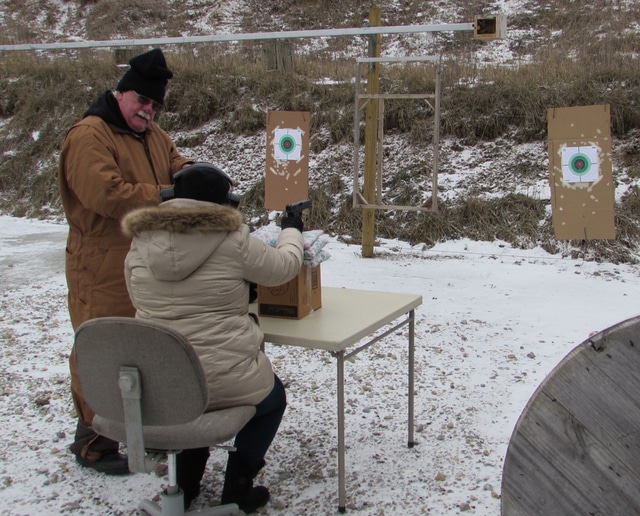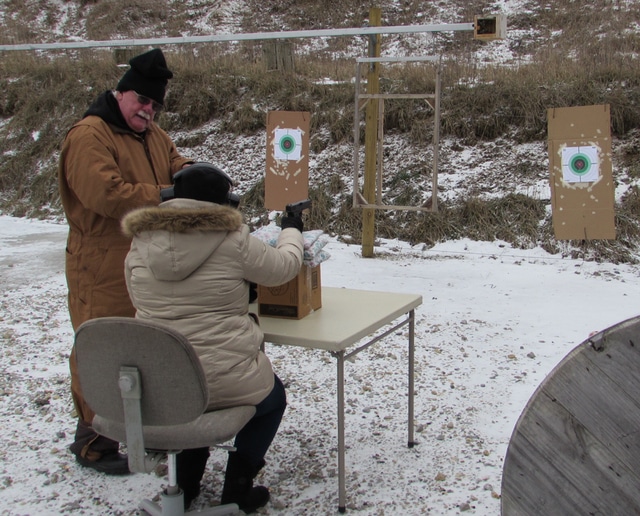

DARKE COUNTY — Planned changes to the National Rifle Association’s (NRA) concealed carry program have been met with displeasure from one local instructor.
Under the NRA’s new “blended learning” certification system, students will do the majority of their work online. After successful completion of the online course, would-be licensees will schedule the remainder of the course with a live instructor.
Mike Lewis of Darke County says personal interaction between an instructor and his students is vital to a learner’s success.
“The new format prevents any question and answer or back and forth between the students and the instructor” he said. “I believe this is one of the most beneficial parts of the class.”
A longtime law enforcement officer, Lewis has been an NRA Certified Instructor for eight years.
“I have been a police officer for 40 years, 28 of which were spent with a larger department in the Dayton area,” he said. “I have been involved in the investigation of many shooting situations and I try to bring to the class some of the lessons I have learned along the way. I am certain that other instructors also do their best to provide their students as much pertinent information as possible. This is all gone with the new format.”
Lewis added, “The new format also prevents instructors from providing any additional information, such as things that can be done to mitigate liability after a deadly force encounter, to better prepare the student to carry a firearm in public.”
“As an example, in my class, we discuss firearm selection, holster selection, accessing the firearm from concealment, edge-weapon assaults, the likely requirement for multiple shots, and many other topics,” he said.
The new blended learning format is expected to become the NRA’s standard by the end of March. The cost of the online portion of the course is yet to be determined, but the “word on the street” is that the price could range anywhere from $50 to $100. Local instructors will establish their own price for the live-training portion of the certification.
Training costs, however, don’t include what a student will pay the state for their license — $67 for the first license for those with five or more years of residency, and $91 for those with less than five years in the state. Renewal fees are $50 and $74, respectively.
Currently, those seeking a concealed carry license (often referred to as a “CCL” or “CCW”) in the Buckeye State are required to have at least eight total hours of training — at least 6 hours devoted to classroom time, the remainder dedicated to live-firing exercises at a range. Upon successful completion of class and range instruction, the student is given a certificate by the instructor.
The student then presents the certificate and a filled-out application, along with a passport-sized photo, to their sheriff’s office where they live. A background check is run and fingerprints taken. Usually within a few week’s time, the applicant can then pick up their license.
Lewis was unequivocal in his opinion regarding the organization’s motivation in moving to blended learning.
“I firmly believe that this change is motivated by the NRA’s desire to increase revenue and has nothing to do with improving training,” he said.
In January, Lewis allowed The Daily Advocate to witness the shooting portion of one of his classes. Four students were on hand at a local outdoor range. Despite snow on the ground and windy 24-degree temperatures, those in attendance were enthusiastic.
Lewis talked to the group — two women and two men — as a whole and also worked with each student individually. Each learner brought his or her own semi-automatic handgun, in 9-millimeter and in 40 S&W calibers — some owned, some borrowed. Safe gun-handling, for their own safety and the well-being of others, was an important aspect of the live-fire training.
The instructor first had each of his students fire one round at a target from a sitting position. His instructions were methodical, explaining step by step to the student how to chamber, aim and then fire the gun.
From there, Lewis had the students fire at targets from a standing position with a two-handed grasp. After each student fired his or her allotted number of rounds, they were instructed to keep their firearm at a “low-ready” position, with arms extended and the gun’s muzzle pointed toward the ground.
Students also practiced firing with one hand, arm extended. Under Lewis’s steady tutelage and after many rounds fired, all four students qualified to apply for their concealed carry license.
“Class size averages about 10. Usually at least a third are women,” said Lewis. “The women typically do at least as well as the men. I do find that most of my people who are new to firearms are women. I have had several elderly folks take the class also, some in their 80s.”
Though the learners at the January class all used semi-auto handguns, Lewis said a revolver is also a good option.
“With regard to gun recommendations, it’s the same for men and women,” he said. “I recommend they carry the largest caliber they are comfortable with and I suggest that they consider a revolver. There are fewer things to cause a malfunction with a revolver.”
“Also, if there is a malfunction, perhaps due to a problem with the ammunition, all you have to do is pull the trigger again,” he added. “If you have a malfunction with an auto, you are out of the fight until you clear the malfunction, reinsert the magazine and actuate the slide. Ammunition issues are much more common than most people think.”
Lewis predicts the number of CCW licensees in the state will increase, despite blended learning.
“I think the number of CCW holders in Ohio will continue to increase, but not at the same rate,” he said. “I think the new online format will slow things down a bit. Also, I think we will eventually reach a saturation point where most of the people who want one will have one. I think we will probably, at some point, have a national CCW license which will be good in every state.”
“I am not in favor of such a permit unless there is some type of standardized training requirement,” he added. “As it is now, some states do not require any training at all and I think that is a bad idea.”
In light of the NRA’s changes, Lewis says the course he ran in January will be the last he conducts.
“That’s not to say that other instructors will not be having more classes,” he said. “Some may go right up to the end of March which is what the NRA tells me will be the absolute end of these classes.”





